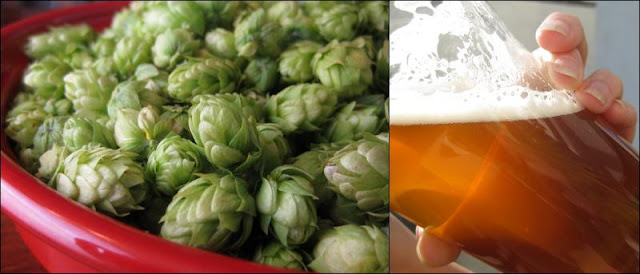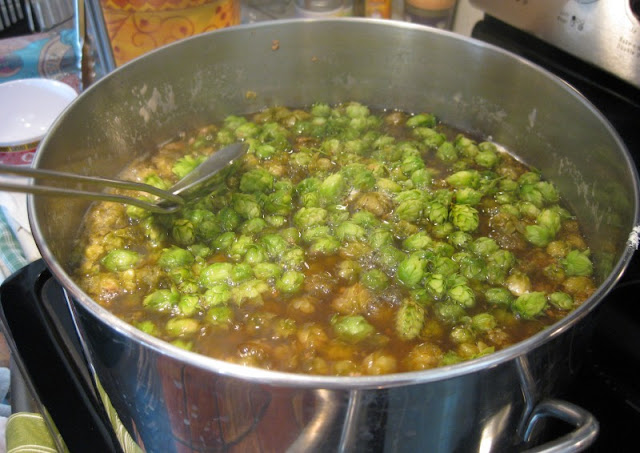Brewing with Fresh Hops - A Wet Hop IPA Recipe

Back in August, we posted about picking fresh Cascade and Nugget hops at Star B Ranch. We've been drinking the beer we made from those hops for a month or so now, so I guess we are overdue on posting about brewing the beer itself.
Scouring the internet didn't turn up a whole lot of information on brewing with fresh hops, and what information we did find was often contradictory. Since our beer turned out well, hopefully this recipe will help the next person searching for information on the subject.

We used our standard west-coast IPA malt bill, so there were no variables to worry about there. With the hops, though, the questions were how much to use, and when? In terms of amounts, the general wisdom seems to be that you want to use about 4-5 times the weight of fresh hops as compared to what you would use with dried hops - this accounts for the extra weight from water in the fresh hop flowers.
Given that we normally use 6 oz of prepared hops, by that calculation we'd need 24-30 oz of fresh - nearly two pounds! But, since we only picked about 18 ounces, that would have to do...
Regarding timing, I had read that you can get too grassy a taste if you boil the hop flowers too long, so we decided to push most of the hop additions later than usual in the schedule.

By the time we had finished adding the hops, they were definitely starting to pile up - you definitely don't want to be using an undersized pot. Once they were saturated with wort, however, they became more manageable.

At the dry hopping stage, space becomes an issue again. We were barely able to get all of the hops into our secondary fermenter. Again, though, they shrunk down as they got wet.

We had also read that dry hopping for too long can cause problems, so we only dry hopped for a week rather than close to two like we usually do.
The result was a very pleasant, subtly hoppy beer. Given that the flavor was not at all overly grassy, I think if we do another fresh hop beer we would move the hop schedule up in the boil and and increase the dry hop time to both increase the bitterness and the aroma.
The recipe that follows is exactly what we did:
Fresh Hops in the Boil and Wet-Hopped in Secondary; Total batch size = 5 gallons; Partial Mash in 3 gallon beverage cooler; ~3 gallon 60 minute stove-top boil; late malt extract addition; target abv of 7.5%. Note: Use the fresh hops as soon after picking as possible; store fresh hops for wet/dry hopping refrigerated in an air-tight container.
5 lb 2-Row Pale Malt
1/2 lb Wheat Malt
1/2 lb Carapils/Dextrin Malt
5 1/4 lb Briess Golden Light Dry Malt Extract (DME)
10 oz Whole, Fresh Cascade Hop Flowers (est. 8% AA)
7.5 oz Whole, Fresh Nugget Hop Flowers (est. 11% AA)
1 tablet Whirlfloc
White Labs WLP001 California Ale Yeast
1/2 oz fresh Nugget - 45 minutes boil
1 oz fresh Cascade - 30 minutes boil
1/2 oz fresh Cascade - 15 minutes boil
1 oz fresh Cascade - 10 minutes boil
1/2 oz fresh Nugget - 5 minutes boil
3 oz fresh Cascade - 0 minutes boil - flameout
3 oz fresh Nugget - 0 minutes boil - flameout
1 oz fresh Cascade - 5 minutes boil
3 1/2 oz fresh Cascade - Wet Hop in Secondary Fermenter
2 1/2 oz fresh Nugget - Wet Hop in Secondary Fermenter
Heat 8 quarts water to 165 degrees for a target mash temperature of 150 degrees. Place the 6 pounds of crushed grain (2-Row Pale, Wheat and Carapils) into a large mesh bag. Pour the hot water into the beverage cooler, then lower the grain bag into the water very slowly, pushing and prodding with a large spoon to ensure all the grain is wet (this can take several minutes). Put the lid on the cooler and allow to rest 60 minutes.
While the grains are mashing, heat another 5-6 quarts of water to 180-185 degrees for sparging (rinsing the grains). Near the end of the 60 minutes, heat 2 quarts of water to a boil in your brew pot.
After the first mash is complete, remove the cooler lid and open the spigot to draw off about 2 quarts of wort into a large pitcher. The first few draws will likely be cloudy with grain particles; pour it gently back into the cooler over the grain bag to help filter it. Draw off the remaining wort by the pitcher-full and carefully pour that wort into the boiling water in your brew pot; continue until only a trickle of wort leaves the spigot. Pour about 5 quarts of your hot sparge water over the grain bag in the cooler. Gently lift the bag up and down to thoroughly re-wet the grains (but don't slosh). Cover and let sit about 5 minutes. Use the spigot and a pitcher to draw off all of the second wort and add it to your brew pot. (Alternatively, heat the sparge water to 195 and carefully add it a pint at a time while you draw off the first wort. Keep the liquid level 1 inch over the grain bed until all sparge water has been added, then slowly draw off the remainder.)
You should have about 3 gallons of wort. Bring the wort to a boil, add 2-3 drops of anti-foam (optional) and add the whole, fresh hop flowers according to the schedule. With 20-25 minutes remaining in the boil, begin adding the DME one cup at a time, stirring to dissolve. Stir in 1 tablet Whirlfloc. At time zero, carefully stir in the last of the hops, remove from heat, cover and let sit 10-15 minutes.
Move brew pot to an ice bath and cool quickly to less than 80 degrees. Strain off the hops then transfer wort to a primary fermenter. Add water to reach the 5 gallon mark. Swirl vigorously then pitch the yeast.
Ferment in primary for 1 week, then transfer to secondary. After 3-7 days, add 3 1/2 oz whole, fresh Cascade hop flowers and 2 1/2 oz whole, fresh Nugget hop flowers. Bottle or keg after fermentation is complete (1 to 2 weeks in secondary).







Holy cow Mike, that is amazing! I love the picture of the carboy brimming with hops! Funny you guys should post this, I just had a wet hopped cask pale ale two weeks ago and I'm still thinking about it. I believe the brewer only added the wet hops to the firkin, but the result was simply amazing. I would love to experiment with something like this next year. Once again, I find myself envious of the west coast!
ReplyDeleteHi Mike - it was fun experimenting with the fresh hops. If you can find a hop source, definitely give it a try.
ReplyDeleteI'd kill to have fresh hops, so cool. As always, your beer recipes look great.
ReplyDeleteI'm thirsty.
Thanks, Dave!
ReplyDeleteYour beer recipes look great! I'm about to brew up some of the Belgian Triple IPA.....really stoked to see how it turns out.
ReplyDeleteGlad you are enjoying the recipes, and good luck with your Belgian IPA!
ReplyDeleteMike, I have just put 125g of freshly picked hops into an APA my primary fermenter (Day 10). Did your hop flowers sink or did you have to dunk them? I am concerned that the exposed flowers may begin to rot?
ReplyDeleteThe hops got saturated and sunk some, but still stayed on top. We didn't have any problem with spoilage, though.
ReplyDeleteCool, hopefully my hops won't cause a problem either. It will be a nervous couple of weeks waiting for the primary ferment to end.
ReplyDeleteBTW, great site and photos
Update on the Harvest Ale - Made it into the bottles with no signs of infection. Still tasted great with no green grass flavours at all. Will report in at first tasting. Thanks for the advice.
ReplyDeleteCracked the harvest ale and it turned out really well. Weird mix of home grown hops but a winner! You can see some pics and get details at http://www.aussiehomebrewer.com/forum/index.php?showtopic=55134&pid=778114&st=0&#entry778114
ReplyDeleteThanks for the advice re: dry hopping
Glad to hear that your harvest ale turned out well!
ReplyDeleteAmazing! I wondered i could get some of these fresh hops here at Brazil. Unfortunately we only get the pellet ones becouse of shipping costs and condittions... It must be amazing to brew with those, the aroma must be great!
ReplyDeleteps. I used one picture of yours at my blog, the one with the dry hopping... is that ok? Thanks!
Hi Bruno - sure, you can use that image. I am usually fine with people using our pictures, as long as they ask permission and credit the photo.
ReplyDeleteThis is just what I was looking for. (We're planting Nugget and Cascade at the cabin; Thanks for posting it!
ReplyDeleteGlad it was helpful, and good luck with your hops!
DeleteHow old were the plants these hops came from? I am about to harvest my first year Zues, Chinook, and Centennial hops. I'm thinking about using pelletized Columbus hops for bittering though, and then using all the first year hops for late additions. What do you think?
ReplyDeleteHi Jim - I'm not sure how old the plants were, but I don't think our source had been producing hops for more than a few years.
DeleteI think using the fresh hops for late/dry hopping is the best way to go - particularly if you don't have very much.
Hi there, Thanks for this article! Great information for a novice. Question I have is about cleaning the hops up. I just picked 8.5 pounds (!) Of fresh cascade. I just want to have them ready for my friend who is a master Brewer when we get set to cook. Is there any roasting I can do or anything else fun I can surprise him with if I showed up with a pound of hops like a toasted caramelized something?. We don't have to use it but hey maybe it'll be a brewtime snack! Thanks!
ReplyDelete8.5 lbs - nice harvest! Fresh is best. Hops are all about aroma, and the oils that produce the aroma are volatile - the less you do to them the better.
DeleteSo, I have several hop plants growing in my yard- and I'm having difficulty identifying them. I know I have Cascade, and Willamette- maybe Golding or Nugget, or both? Do you think it matters terribly if I mix them up in the process? Will it make that much of a difference? I'm sincerely curious... so I may have to answer this myself by experimenting. Thanks for this recipe- I'm going out to buy ingredients.
ReplyDeleteEven f you don't know which they are, just go ahead and use them - I'm sure it will come out fine.
DeleteOk, two questions, since I'm a newbie to this: what is the difference between "wet" and dry hops? This recipe speaks to both, but I'm sorta confused...
ReplyDelete"Wet" or "Fresh" hops refer to hops straight off of the vine (as opposed to dried leaf or pellet hops). "Dry hopping", however, refers to adding hops (fresh or not) after the boil - usually in secondary fermentation.
DeleteHey Mike, quick question about adding the whole cone hops to the secondary. How does this not infect the beer when you dump/cram a ton of raw plant material in your fermenter?
ReplyDeleteThanks for the best article with recipe out there!
Steve
Hi Steve - I haven't heard about any particular risk of infection from dry hopping with fresh hops. By the time you add the hops in secondary, fermentation should be mostly complete and I think it is low-risk environment for infection.
DeleteGreat - glad to hear it!
ReplyDeleteThanks for sharing :-) Have linked to this http://wildcraftvita.blogspot.it/2013/09/things-to-do-with-hops.html
ReplyDeleteYou wrote that if you did the Cascade/Nugget Wet Hop brew again that you would change the hop schedule. Can you identify specifically what that change might be?
ReplyDeleteHi Frank, It's been a while since we brewed this one, but I think we'd primarily move some of the hops from the flame-out point to the 60 and 45 minute boil points instead (even better would be to have more fresh hops in general, adding the additional amounts to the front of the boil). Also, we wouldn't wait the 3-7 days after racking to secondary before adding the dry hops - add them right away instead.
ReplyDeleteQuestion about fresh hops for secondary - how did you store them until it was time to get that secondary fermentor hopped up?
ReplyDeleteHi Ed, I think we just put them in zip top bags, pressed out the air, and stored them in the fridge. But if you have a vacuum sealer, and big enough bags, that would probably be your best bet (still refrigerate though!).
ReplyDelete